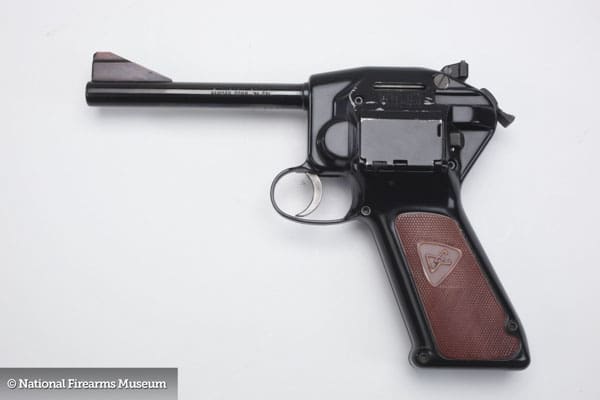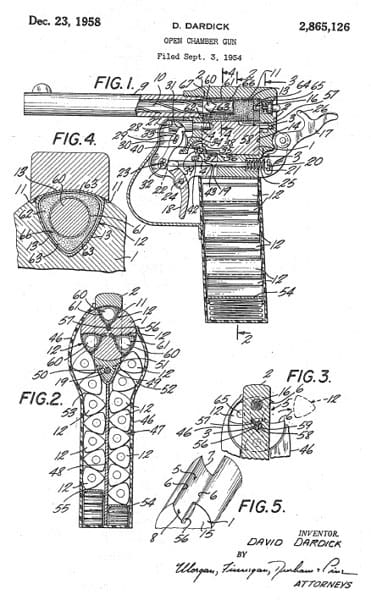
In August 1958, David Dardick received a patent for a magazine-fed revolver. His design featured a cylinder with openings on each exterior edge, creating U-shaped chambers instead of traditional O-shaped chambers. This allowed rounds to be automatically fed into the chamber from a magazine loaded with a stripper clip, instead of being loaded manually like in a traditional revolver. Additionally, extraction was also done automatically.

Dardick soon realized that his U-shaped chambers would require it to be fed in a very specific fashion in order for his revolver to function properly. By the end of 1958, he was issued a second patent that shows his ammunition now being three-sided like a triangle. The uniform size of the round on each side enabled it to feed into the cylinder more easily, thereby increasing the gun’s reliability.
The new triangular ammunition needed a name, so Dardick called them “trounds,” a combination of the words “triangle” and “round.” The bullet, powder, and primer were all loaded into the triangular-shaped plastic case that created the outer wall of the revolver’s cylinder.
Dardick’s first gun, the Model 1100, was only chambered for the proprietary .38 Dardick Tround. However, a cylinder adapter could be purchased, which allowed the shooter to fire traditional handgun ammunition. Next up was the Model 1500, which had interchangeable barrels and could fire .38, .30, and .22 caliber trounds. This model was also available with a carbine conversion kit to turn the revolver into a rifle.

Shortly after introduction to the public, Mechanix Illustrated magazine featured an article on the new gun. Its author called it “as versatile as a six-armed monkey.” While the analogy may seem to be an unusual way to praise Dardick’ s creation, it proved to be accurate in a way the author never intended: just like there’ s no such thing as a six-armed monkey, there’ s also no such thing as a commercially-successful, magazine-fed revolver that fires rounds from a plastic triangle.
The public never embraced his concept and Dardick’s trounds remain little more than a footnote in the advancement of ammunition.
Logan Metesh is a firearms historian and consultant who runs High Caliber History LLC. Click here for a free 3-page download with tips about caring for your antique and collectible firearms.



A solution in search of a problem.
Heh.
See “Metal Storm” for another example.
These type articles are first-rate. More.
His next patent was the football bat.
I just blew a snot rocket mixed with coffee!
Don’t eat the whole thing, save some for later.
As kids, a friend and I use to play home run Derby in the yard with a wiffle bat and Nerf football
Luckily it was maybe 50-60 feet to clear the fence 🙂
It seems to me that the phrase “advancement of ammunition” is being used very loosely here.
https://www.youtube.com/watch?v=MTh0EMAH99A
‘Nuff said.
A foreshadowing of today’s efforts to make a viable plastic-cased telescoped cartridge.
Very nice. And I’ve wanted one ever since I read Tom Paine Maru.
I actually read of this in a science fiction novel by libertarian L. Neil Smith, Tom Paine Maru. They referred to it as an automatic revolver or a revolving automatic. Perfect for mystery writers that cant tell the difference.
Right up there with the Gyrojet rocket gun. File under innovative but dumb ideas.
not one of these “breakthrough ideas” solve any problems except for problems brought about by the idea of this automatic revolver. That said. IF there was a case resizing die that would reshape conventional 44 mag cases to fit these wankel engine rotor shaped cylinders, I’d give is a go
I remember a long time ago that Numrich had parts for the Dardick.
Aren’t the Dardicks the enemies of the Doctor?
Seems like I remember reading that some large caliber full auto guns were tested. Potential rate of fire was very high. I can’t Google it at the moment.
I know what you are talking about here’s a video of a .50 version:
https://www.youtube.com/watch?v=MTh0EMAH99A
It seems like it’d be great for an aircraft cannon for reducing weight. Take it a step further and make the rounds caseless and you have a chamber-less and ejector-less weapon capable of very high rates of fire for much less weight than a standard system.
Forgotten Weapons has a very good episode on the Dardick.
When I was a kid, I remember seeing an advertisement for one in an old science magazine in my Opa’s attic. Back then I thought it looked like a price-tag gun… but still thought it cool and have wanted it ever since.
There is a market for Dardick guns. Originally boxed mint examples go for big bucks. I saw a site where someone figured a way to load. 22 ammo into the.38 shells or something along those lines.
Not really a defense gun.
Triangular cases sounds interesting. You could probably fit a lot more rounds into a magazine if they were shapped that way. The flat sides of triangles could be pressed togethor which would get a few extra rounds. It would be making better use of the space.
The patent illustration above shows space for 15 trounds plus three in the cylinders, with a spring shown not fully compressed allowing perhaps a16th to be carried.
I’m searching the Internet for the legendary Dardick Electric Fork.
I didn’t have a theory that Dave Dardick bowed out of firearms development after this pistol flopped, and changed his name to Ron Popeil… but I do now.
I’d like to see my obscure object, the Fedorov Avtomat , I’ve never seen one outside of book, I’m not sure that there are any in the U.S. but damm their cool.
please don’t damn their cool, they get hot after 400 rounds.
Good old” Mechanix Illustrated”. Home for every hare-brained idea that could inspire a 12 year old boy to become an engineer. I mean that in a good way.
I have similar impressions after reading.
My inner teenager wants to touch and disassemble this gun.
Ok, so the Kriss Vector is NOT the ugliest gun ever… no, wait. Yes it is.
But, why?
Dardick then moved on to Remington where he was chief designer for handguns 🙂
Actually, the Dardick design sought to solve several problems inherent in semi-auto pistol design. It suffered from being a) ugly (even uglier than a Glock) and b) the military wasn’t really keen on acquiring a new pistol yet, and c) ammo was expensive. Any fundamentally new ammo will be expensive – ammo costs are a function of economies of scale.
While the Dardick was a commercial failure, his approach to solving some of the issues in a semi-auto handgun were unique and showed a great deal of creativity.
The ridicule of it being a “semi-auto revolver” shows a lack of understanding of two of the problems he was seeking to solve: magazine density and plastic-cased ammo. When you see the insides of a Dardick, and how the cartridges load into the firing position, you see that it isn’t really a revolver in the conventional sense. The chambering, firing and ejection positions on the cylinder all serve an individual purpose, and none of those “cylinder positions” is there to store ammo.
Looked to me as if he was trying to build a handheld Gatling gun.
Not quite. A Gatling has multiple barrels. Dardick was trying hard to solve two problems, and then a couple of other issues were supposed to be “side-benefits” of the design.
The two problems were:
1. Increase ammunition capacity in a semi-auto pistol. What we now do with double stacks, he did in abundance with the “tround” idea. You can pack a lot more rounds in if only you didn’t have all that wasted space between tangental meeting points.
2. How to load ammo into the ‘chamber’ completely independent of what the projectile looks like, every single time. If you look at a ‘tround,’ you see that the bullet is recessed inside the plastic – so the shape of the bullet means nothing to the loading cycle of the Dardick. In fact, the ‘tround’ is pushed into the chamber sideways, not longitudinally, so the OAL and shape of the bullet really means nothing to the entire enterprise.
The fringe benefits were supposed to be:
1. The plastic rounds would be as light or lighter than brass-cased rounds,
2. The cost of the ‘tround’ should be lower, because they can be made with injection molding.
Dardick actually went on to use his tround concept in a 30,000 rpm Gatling gun for aircraft armament. The tround allowed linkless feed at this incredible cyclic rate.